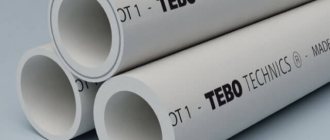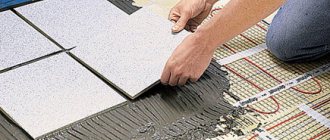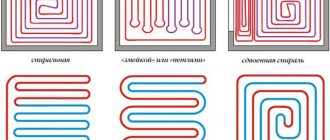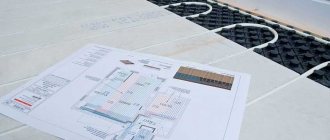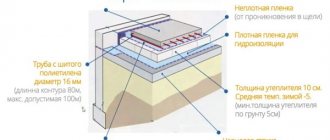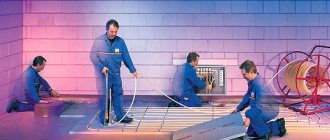Heating based on underfloor heating is more energy efficient, does not affect the aesthetics of the room, and evenly warms the space. Since communications are walled up in concrete for decades, it is very important not to make a mistake with the choice of material. There are two types of pipes that experts recommend - metal-plastic and cross-linked polyethylene. Which pipes are best to use can only be decided after studying their properties.
Criterias of choice
When choosing a material for the construction of communications, the decisive argument should not be considerations of economic benefit or installation complexity, but the compliance of the technical characteristics of the pipes with the expected operating conditions.
In the case of installing heated floors, the following requirements apply to pipe materials:
- Durability . According to official requirements for pipes for heated floors, it is prohibited to use ferrous rolled metal and seamed pipes. Steel products without special anti-corrosion protection in a walled-up state will not last long. The connecting seam is a “weak” point when hydraulic pressure increases in the heating system. The use of such materials will quickly lead to an emergency situation, the elimination of which will require opening the concrete screed.
- Chemical inertness . For long-term operation without reducing the internal clearance, pipes with a perfectly smooth inner wall are required. The coolant contains salts of alkaline earth metals, which, during long-term operation, are deposited on the inner walls of most pipe materials.
- Resistance to mechanical loads without deformation . The minimum concrete screed exerts a pressure on the pipes equal to 10 kg of weight per square meter. cm. Soft plastic pipes will be deformed under this load, and too hard plastic may burst.
- Resistance to high temperature and pressure of the carrier in the heating system . The minimum required stability parameters are 95 degrees and 10 atm. respectively.
- High level of heat transfer . For efficient heating, it is important that communications are not a barrier between the coolant and the air.
- No connections under the screed . Pipe materials are required that can be laid in one piece up to 120 m long.
- Flexibility and fracture resistance . When laying heated floors, it is important that the pipes are flexible enough to bend without damaging the walls and deforming the internal section with a minimum radius. Large distances between pipes cause cold segments.
We recommend that you read: How to choose drainage pipes with perforation when installing drainage systems
The choice of this or that material is also influenced by the type of heating in the house. If this is a central system, then the heated floor will be subject to more severe loads than with an individual circuit.
Note! Those looking for the ideal option for underfloor heating should consider using copper materials. Copper has a much greater safety margin than is necessary in this case. There are two disadvantages - complicated installation and high price of copper pipes.
Metal-plastic and cross-linked polyethylene are very close in their technical and price characteristics. Comparing their positive and negative sides will allow you to make the right choice in each specific case.
Metal-plastic vs cross-linked polyethylene - which pipes are better?
The question - which pipes to choose - metal-plastic or cross-linked polyethylene - faces every second buyer who decides to make or replace a pipeline. Although there is no clear answer to this question, we will try to analyze the pros and cons of both options.
On the Internet you can often find heated debates on this topic, some compose odes to metal-plastic, others are in love with Rehau cross-linked polyethylene and do not notice other pipes, although there are many of its analogues today. There are also opinions from “experienced specialists” that rehau pipes are metal-plastic, with reference to the fact that it is written about this on the manufacturer’s website, however, this is just an error in translation...
Perhaps any experienced installer will agree that it is not wise to compare metal-plastic and cross-linked polyethylene. They have different properties and features, although they are equally ready to last quite a long time (50 years) with proper installation and operation.
We will not go into detail and again list all the pros and cons, but will simply look at the differences between one type of pipe and another:
- A bend on a PE-Xa pipe is not dangerous ; it can be restored using a hair dryer, but in the case of metal-plastic, such a section needs to be cut out or a press coupling installed. But any connections in the heated floor circuit are extremely undesirable, and here everything needs to be done carefully without creases.
- Cross-linked polyethylene is much more plastic than metal plastic and bends easily , and also has “shape memory”, so you need to use rotation angle clamps. Metal-plastic pipes look neater when laid open.
- Due to different linear expansion of the layers, a metal-plastic pipe can delaminate , which also causes leaks at the joints.
- Metal-plastic pipes are considered more affordable in terms of price (most likely because of the tools), which almost every second person undertakes to install, even if not a plumber. However, you can be sure that nothing will leak after installation only if the installation was performed by a professional and, due to “crooked hands,” the connections were not pinched and the pipe was not damaged.
- Rehau cross-linked polyethylene can withstand freezing of the coolant in pipes , while metal-plastic can tear.
To summarize, both pipes are good and can be used in water and heat supply systems in private houses and apartments. For heated floors, it is better to use Rehau or its analogues, since it is important to lay pipes without kinks or joints. If in the case of cross-linked polyethylene on a sliding sleeve the operating error is reduced to zero, then when laying metal-plastic pipes there is a risk of clamping the connection too tightly, which can cut through the pipe.
Figure 2. Properties of cross-linked polyethylene pipes for heated floors
Rehau is, without exaggeration, 100% high-quality and reliable pipes and fittings; all negative reviews, to one degree or another, arise from the brand’s relatively high pricing policy. But the price includes not only the cost, but also a guarantee of quality. But they complain about Oventrop and Valtec precisely because of leaks and poor quality pipes.
When buying cross-linked polyethylene pipes in an online store, it is important to immediately select fittings and sleeves. With their help, the process of installing Rehau pipes takes a minimum amount of time, and the entire heating circuit is 100% durable and airtight.
Polyethylene pipes
Cross-linked polyethylene is a modern high-tech chemical product. Cross-linking of the polymer occurs at the molecular level. Ordinary polyethylene is a long linear chain of molecules. Modern technologies allow chemists to link these molecules together with strong additional chemical bonds. Just as threads form strong fabric, linear molecules form a three-dimensional web of cross-linked polyethylene.
There are several technologies for the production of cross-linked polyethylene. They differ in their cost, percentage of connected linear molecules at the output, and labeling. To install a heated floor, pipes with a crosslinking percentage of at least 65% are required.
PEX-a pipes have up to 85% cross-linked molecules. Their production process is quite expensive, but guarantees high-quality material. The technology for producing PEX-b pipes is cheaper, but produces only 65% of the connected molecules.
Note! Pipes marked PEX-c for floor insulation are not reliable enough.
The best properties of polyethylene pipes:
- High elasticity – allows pipes to be laid as close to each other as possible without damage.
- Low expansion coefficient. Cross-linked polyethylene does not “walk” under concrete when the temperature changes. Resistance to mechanical influences from outside and outside. The material does not deform under the concrete screed and does not burst when frozen with water.
- The ability to return to its original form. This guarantees tightness when using fittings and no deformation at the bend.
- Inert to chemical and biological influences. Pipes do not rot or be destroyed by aggressive environments.
- Compliance of the technical characteristics of the material with operating conditions. Cross-linked polyethylene can withstand water heating up to 90 degrees (recommended temperature 80) and pressure up to 8 atm.
We recommend that you read: How to make and install a protective exhaust hood on a chimney
Cross-linked polyethylene has few disadvantages and they are related to installation. The high elasticity of the material in bending requires pipelayers to rigidly fix the pipes during installation. The second point is the need to preserve the external protective coating. This makes the work somewhat more complicated compared to metal-plastic.
Which is better: cross-linked polyethylene or metal-plastic for heated floors?
When starting to install a heated floor, the question arises which pipe material is better: cross-linked polyethylene or plastic.
The answer lies in the operating conditions of the heated floor, and the opinions of specialists, experience and reviews of people who have been operating floor heating systems for more than one year will help to understand this issue.
Almost all modern pipes are based on cross-linked polyethylene; only metal-plastic pipes have a metal reinforcing layer with adhesive layers added to the outer and inner layers of cross-linked polyethylene, ensuring the solidity of the product.
Metal-plastic pipe products for floor insulation
Metal-plastic pipes were originally developed for constructing closed floor insulation systems. These materials have a complex, multilayer structure, where the supporting element is aluminum foil. Adding metal to cross-linked polyethylene eliminates its disadvantages, but adds its own characteristics that should be taken into account during installation.
To understand how a metal-plastic pipe works, you need to understand its structure. The material is a “sandwich” of two layers of polyethylene covered with metal. The bonding agent is a special glue that is applied to the metal foil on both sides.
Aluminum inclusion adds metal-plastic to all the advantages of polyethylene pipes:
- resistance to water hammer;
- higher operating parameters - pressure up to 10 atm, temperature up to 95-100 degrees (recommended 93);
- faster and more efficient heating of the room;
- the ability to maintain the bending shape without fixation, which simplifies installation.
When choosing high-quality pipes, you will not encounter any disadvantages. Poor-quality metal-plastic can create problems during installation. A poor adhesive base leads to delamination of the pipe, and thin foil will quickly break at a break.
Note! Installation of a metal-plastic floor is carried out at a distance of 35 cm. Closer installation will lead to deformation of the pipe at the bend.
The main danger of metal-plastic
However, this is not the main danger - everything lies in the composition of the metal-plastic: inner polymer layer - adhesive layer - aluminum - again special glue - outer layer of polymers. During operation, the product is heated by hot liquid, but the thermal expansion of each layer is different from each other, which leads to deformation of the metal over time and weakening of the pipe.
Leaks occur, which are eliminated first by “tightening” the fitting, but the time comes when the nut is tightened as much as possible and damages the aluminum layer - the internal cross-section will close, and if you press the nut more, the pipe may simply break. To eliminate the accident, you need to install a new fitting, which will entail the need to lengthen the pipeline, and this is a serious blow to the level of reliability. Cross-linked polyethylene does not have such problems.
You should also take into account another significant drawback of a metal-plastic pipe (when compared with products made of cross-linked polyethylene). We are talking about the narrowed flow section of all fittings - it is much smaller than the pipe itself. As for cross-linked polyethylene, the technology for installing such pipelines is the exact observance of all cross-sectional dimensions of the pipes that are included in the structure.
Source
